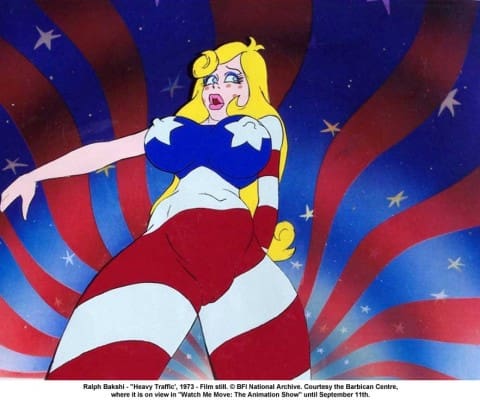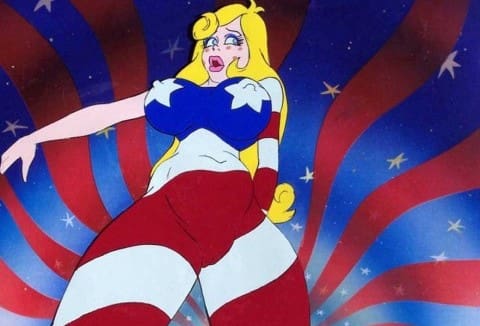

The London Barbican Art Gallery Presents 150 Years of Animation

London- The Barbican Centre is proud to present Watch Me Move: The Animation Show, on view until September 11th. Watch Me Move is the most extensive exhibition ever mounted to present the f ull range of animated imagery produced in the last 150 years. It brings together industry pioneers, independent film-makers and contemporary artists including Etienne-Jules Marey, Harry Smith, Jan Svankmajer, William Kentridge and Nathalie Djurberg alongside the creative output of commercial studios such as Walt Disney, Aardman, Studio Ghibli and Pixar. Presenting animation as a highly influential force in the development of global visual culture, Watch Me Move explores the relationship between animation and film and offers a timely insight into the genre as a cultural phenomenon. Cutting across generations and cultures, the show features over 170 works, from iconic clips to lesser-known masterpieces. Taking the viewer behind the dream-world of the finished film, it includes puppets, stage sets, storyboard drawings, wire-frame visualisations, cel and background images.
Transforming the gallery into an immersive environment, the exhibition is divided into seven interconnected themes: Apparitions, Characters, Superhumans, Fables, Fragments, Structures, and Visions. The first section Apparitions focuses on the emergence of the animated image, from early scientific experiments with photography to computer generated imagery. A pioneer of time-lapse photography, Percy Smith, captures the unseen wonders of the natural world. In The Birth of a Flower,1921, snowdrops and roses blossom in seconds. Speeding up time with his split-second frames photographer Eadweard Muybridge created now iconic images of animals and humans in motion are also on show. Breathing life into static objects, John Lasseter?s first film for Pixar Animation Studios, Luxo Jr, 1986, follows the antics of a small desk lamp, as its elder lamp affectionately looks on. Contemporary artist Christian Boltanski’s Shadow Cinema, 2011, features cut out silhouettes flickering gently on two large lightboxes, reminiscent of the modest graphic origins of animation.
In the 1930s there was a distinct shift from the early experimental animation to a series of cartoons and feature films designed to attract the masses. Characters presents a host of some of the biggest stars of our animated screens ( on cinema and TV) many borne of that time and still popular now. They include Mickey Mouse, Koko the Clown, Tom & Jerry, The Flintstones, Yogi Bear, The Simpsons, Nick Park?s Creature Comforts and the celebrated cast of Toy Story. Whether drawn in pencil, cut with scissors, modelled from clay or generated by the click of a mouse, Characters demonstrates animation?s ability to construct strong, funny, emotive and complex personalities. This section also includes less well-known characters, showing the power of animation to convey social and political issues. For example Tim Webb’s award-winning film, A is for Autism, 1992, which combines word, drawing, music and animation by people with autism.
Individuals with extraordinary powers are a staple of post-war animation. Marvel and DC comics elaborated an initial line-up, while a parallel, more diverse roll-call was created by the Japanese manga and anime industries. Super humans tend to be ordinary humans, who have been possessed or traumatized beyond the realm of normal experience. In Betty Boop, Ha! Ha! Ha!, 1934, our protagonist accidentally inhales laughing gas causing her whole world to become hysterically alive; in Ralph Bakshi’s ambitious feature Hey Good Lookin?,1982, the character Crazy hallucinates himself into an orgy of violence and sex during a rooftop shooting spree; whilst the Hulk is an ordinary young man whose body is chemically altered, giving him remarkable strengths coupled with a profound sense of alienation. Other highlights include, Astro Boy, 1963-66, set in a futuristic city in 2030, featuring the amazing adventures of a child robot with superpowers. Originally created as a manga character in 1952, by the legendary Osamu Tezuka, it captured the imagination of a nation in need of hopes and dreams. People have always told and retold stories, whether real or imagined. The technical and artistic qualities of animation, in all its forms, have made it the ideal medium to interpret myths, fables, fairy tales and other forms of collective story-telling. Fables includes one of the oldest surviving animated feature films,The Adventures of Prince Achmed, 1926, by Lotte Reiniger. Captivating, intricate and beautiful, it features a silhouette technique invented by Reiniger that involved manipulating cardboard cut-outs and thin sheets of lead placed under a camera, then animated frame by frame. In 1937 Walt Disney made history with the release of Snow White, his first full-length animated feature in glorious Technicolor.
Fragments demonstrates the potential of animation to construct individual stories. The charming simplicity of Belgian artist Francis Alese;’s The Last Clown,1995-2000, uses illustrated line and colour wash to create the humorous tale of a lone, thoughtful man walking up a hill who encounters a dog, stumbles, gets his foot caught in the animal’s tail, and falls. Also on show is Tim Burton’s Vincent, 1982, a six minute stop-motion film about a young boy, Vincent Malloy, who longs to be like the actor Vincent Price (narrator of the film) and is obsessed with the tales of Edgar Allan Poe. Since the earliest days of film, artists have experimented with its most basic properties (form, sound, movement and duration) often for the sheer pleasure of witnessing the results. Structures includes the film Tango, 1980, by Zbigniew Rybczenski. A collage of overlapping time and space, it shows individuals entering a claustrophobic room, repeatedly, until it fills with a crowd of people, each seemingly obl ivious to their neighbours. A Colour Box, 1935, is a riot of light and motion whereby Len Lye painted geometric patterns directly onto celluloid, to a soundtrack of Cuban music. Conveying the excitement of possibilities the moving image presents, Lye later adapted the film for the GPO Film Unit to advertise the postal system. Norman McLaren?s remarkable film Neighbours, 1952, uses stop-motion filming with live characters and props, weaving a dizzying visual tapestry in which two neighbours live peacefully in adjacent cardboard house. When a flower grows between their houses, they fight each other to the death over the ownership of the single small bloom.
Visions looks at how animation has taken us into a whole new virtual sphere. Thanks to the breath-taking realism of CGI technologies, and the emotional persuasiveness of new media techniques, this world is now almost inseparable from our own, as the real and the imaginary continue to collude. Disney’s pioneering film Tron,1982, was inspired by the emerging gaming industries, which developed out of the first commercially viable video game, Computer Space, in 1971. Nearly thirty years on, Avatar, 2009, used technologies that were effectively developed games engines, now so sophisticated that virtual characters (derived from motion-capture renderings of real actors) could be made to move as if through real space. RMB City is the online world of Second Life conceived by Beijing artist Cao Fei (aka China Tracy) as a place for participants (currently around 20 million users) to create a parallel reality in which to live out their dreams. A comprehensive programme of events, films and talks also accompanies the exhibition.

.png)